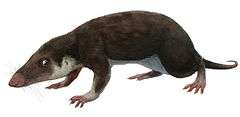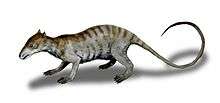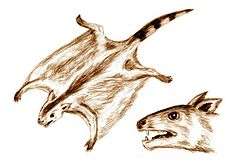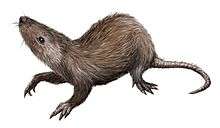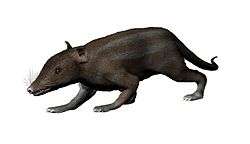Coryphodontidae
Coryphodontidae is an extinct family of pantodont mammals known from the Late Paleocene to the Middle Eocene of Eurasia and North America.[2]
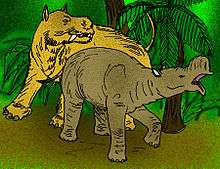
| Coryphodontidae | |
|---|---|
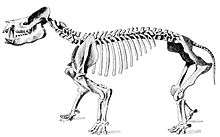 | |
| Coryphodon skeleton | |
| Scientific classification | |
| Kingdom: | |
| Phylum: | |
| Class: | |
| Order: | |
| Suborder: | |
| Superfamily: | †Coryphodontoidea |
| Family: | †Coryphodontidae |
| Genera[1] | |
| |
| Synonyms | |
| |
The type genus Coryphodon is known from around the Paleocene-Eocene transition in Europe, western United States, northern Canada, and eastern Asia. The remaining genera are known exclusively from the middle Eocene of Asia.[3]
The coryphodontids are related to the pantolambdids. Coryphodon are large, derived pantodonts first described in the mid-19th century, but no intermediate stages leading to their unusual upper molars are known.[4] The last known species of Coryphodon have bilophodont molars similar to later, more derived coryphodontids, and, most likely, Coryphodon is the primitive sister taxon to the remaining genera and the entire lineage (or lineages) originated from within this genus.[5] Two coryphodontids considerably larger than Coryphodon but endemic to China, Asiocoryphodon and Heterocoryphodon, have more advanced bilophodont dentition.[6] Metacoryphodon is morphologically transitional between Coryphodon and Eudinoceras.[7]
Corypohodontids were slow-growing and long-living animals, and studies of a large sample of individuals from a single locality, assumed to be from the same population, suggest that coryphodontids had a polygynous social structure in which males and females reached sexual maturity at different ages.[2][8]
Notes
| Wikimedia Commons has media related to Coryphodontidae. |
- Coryphodontidae in the Paleobiology Database. Retrieved July 2013.
- "New Material of Mammal Coryphodontid Found From the Erlian Basin Of Nei Mongol". Institute of Vertebrate Paleontology and Paleoanthropology, Chinese Academy of Sciences. August 2012. Retrieved 20 July 2013.
- Lucas & Tong 1988, Introduction
- Rose 2006, p. 118
- Uhen & Gingerich 1995, p. 265
- Lucas 2001, p. 213
- Chow & Qi 1982, p. 312
- Mao & Wang 2012, p. 276
References
- Chow, Minchen; Qi, Tao (1982). "Mammals from the Middle Eocene Kuanchuang Formation of Xintai, Shandong" (PDF). Vertebrata PalAsiatica (in Chinese and English). 20 (4): 302–14. Retrieved 20 July 2013.CS1 maint: ref=harv (link)
- Cope, E. D. (1873). "On the short footed Ungulata of the Eocene of Wyoming". Proceedings of the American Philosophical Society. 13: 38–74. Retrieved 20 July 2013.CS1 maint: ref=harv (link)
- Flerow, Constantin C. (1957). "A new coryphodont from Mongolia, and on evolution and distribution of Pantodonta" (PDF). Vertebrata PalAsiatica. 1 (2): 73–81. Retrieved 20 July 2013.CS1 maint: ref=harv (link)
- Lucas, Spencer G. (2001). Chinese Fossil Vertebrates. Columbia University Press. ISBN 9780231504614. Retrieved 20 July 2013.CS1 maint: ref=harv (link)
- Lucas, Spencer G.; Tong, Yongsheng (1987). "A New Coryphodontid (Mammalia, Pantodonta) from the Eocene of China". Journal of Vertebrate Paleontology. 7 (4): 362–72. doi:10.1080/02724634.1988.10011670. JSTOR 4523161.CS1 maint: ref=harv (link)
- Osborn, O. C. (1876). "On some characters of the genus Coryphodon uhen". American Journal of Science. 3: 425–28. Retrieved 20 July 2013.CS1 maint: ref=harv (link)
- Osborn, H. F.; Granger, Walter (1932). "Coryphodonts and Uintatheres from the Mongolian Expedition of 1930" (PDF). American Museum Novitates. 552. Retrieved 20 July 2013.CS1 maint: ref=harv (link)
- Osborn, H. F. (1924). "Eudinoceras, Upper Eocene amblypod of Mongolia". American Museum Novitates. 145. hdl:2246/3225.CS1 maint: ref=harv (link)
- Owen, R. (1845). Odontography; a treatise on the comparative anatomy of the teeth. London: Hippolyte Bailliere. OCLC 727240564. Retrieved 20 July 2013.CS1 maint: ref=harv (link)
- Simons, Elwyn L. (1960). "The Paleocene Pantodonta". Transactions of the American Philosophical Society. Philadelphia: American Philosophical Society. 50 (6): 3–99. doi:10.2307/1005810. JSTOR 1005810. OCLC 1891164.CS1 maint: ref=harv (link)
- Uhen, Mark D.; Gingerich, Philip D. (1995). "Evolution of Coryphodon (Mammalia, Pantodonta) in the Late Paleocene and Early Eocene of Northwestern Wyoming" (PDF). Contributions from the Museum of Paleontology, University of Michigan. 29 (10): 259–89. OCLC 742731820. Retrieved 20 July 2013.CS1 maint: ref=harv (link)
- Mao, Fang-Yuan; Wang, Yuan-Qing (2012). "Coryphodontids (Mammalia: Pantodonta) from the Erlian Basin of Nei Mongol, China, and their biostratigraphic implications" (PDF). Vertebrata PalAsiatica (in Chinese and English). 50 (3): 258–80. Retrieved 20 July 2013.CS1 maint: ref=harv (link)
- Xu, Y. (1976). "Some new forms of Coryphodontidae from the early Eocene of Xichuan, Honan" (PDF). Vertebrata PalAsiatica (in Chinese). 14: 185–93. Retrieved 20 July 2013.CS1 maint: ref=harv (link)
